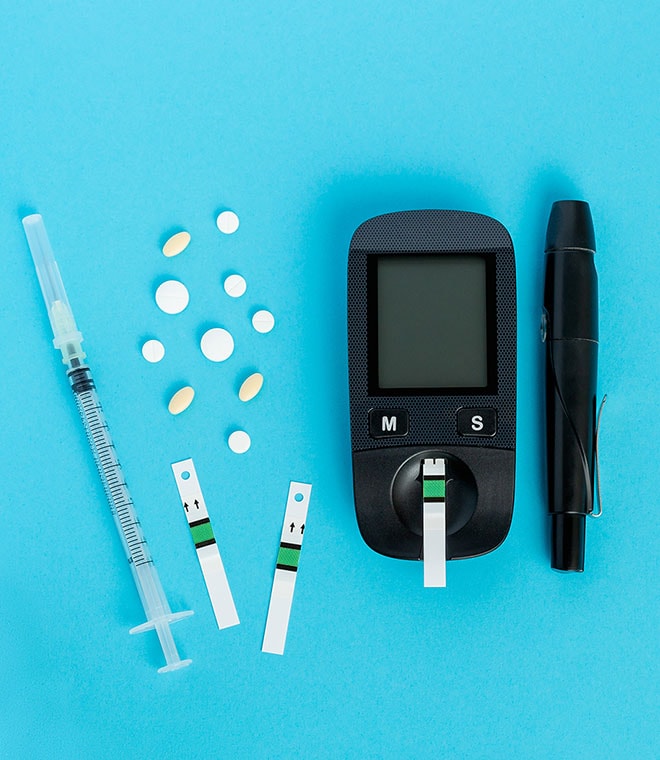Health
Walk away from diabetes
By Jenilee Matz, MPH Nov 06, 2023 • 7 min
Exercise is often part of a diabetes treatment plan, and for a good reason. Physical activity aids in blood sugar control and weight loss efforts. Walking, in particular, is one of the best ways to be active since it's low intensity and can be done almost anywhere. Learn how walking and other forms of exercise can help manage and prevent type 2 diabetes and how to get started with fitness.
How exercise helps manage diabetes
Physical activity offers numerous benefits for people with diabetes. Low- to moderate-intensity aerobic activity, such as walking or jogging, promotes a short-term decrease in blood glucose (sugar) levels. This effect can last up to 24 hours, depending on the length and intensity of your exercise session. This happens as a result of glucose that's stored in your muscles being used up during physical activity. After your workout, your body will take glucose out of your bloodstream to replenish lost glucose stores, which results in lower blood sugar levels. Exercise also helps your body use insulin more efficiently, improving blood sugar control.
What's more, physical activity burns calories, meaning it can help you reach weight loss goals. If you're already at a healthy weight, consistent exercise can help you maintain your weight and stave off weight gain. Exercise also reduces the risk of cardiovascular events, such as heart disease and stroke, and improves feelings of stress and depression.
Physical activity's impact on prediabetes
Not only is physical activity helpful in managing diabetes, but exercise can also help decrease the chance of developing type 2 diabetes in the first place. People with prediabetes have elevated blood sugar levels and a higher risk of developing diabetes. However, healthy lifestyle changes, including regular exercise, can help prevent or delay diabetes in people with prediabetes. Reaching and keeping a healthy weight can lower your risk of diabetes, and exercise can help you shed those extra pounds. But even if you don't lose weight, physical activity on its own has been shown to help keep diabetes at bay.
Walk this way
Before you increase your activity level, talk to your healthcare provider. They may recommend that you avoid certain fitness moves or take special precautions, such as testing your blood sugar before and after exercise to learn how your body responds to different activities.
Brisk walking is a good exercise option for many people since the only equipment you need is a good pair of shoes. When it comes to walking, there's no learning curve, it's generally considered safe and it's enjoyable to do with others. Walking is also relatively easy to stick with since you can do it almost anywhere. Try these tips to get started:
- Wear the right shoes. Wearing comfortable, supportive shoes can help protect your feet and lower your chance of diabetes-related foot problems. Choose athletic shoes and socks that fit well, and never walk around barefoot.
- Ease into it. Strive to be active for 30 minutes a day, five days per week. But don't worry about meeting that requirement right off the bat. Instead, start with 5-10 minute walks. Gradually extend the duration of your sessions as you get in better shape. Consider increasing the intensity of your walks over time, too, by picking up your pace or adding hills to your route.
- Move throughout the day. If you don't have a 30-minute block of time to be active, don't worry. Some exercise is always better than none. Any time you spend moving throughout the day counts toward your exercise goal. Walking from your car to workplace, taking the stairs instead of the elevator, doing yardwork, vacuuming—it all adds up. Try to move more and sit less. Consider setting an alarm to go off throughout the day to remind you to get up and move for a few minutes.
- Add it to your calendar. Schedule your daily workout like you would any other important appointment. Carving out time for exercise in advance can help you stick with it.
- Grab a buddy. Ask a neighbor to join you for evening walks around the block or start a walking club at your office. Working out with a friend or coworker can make fitness more enjoyable. It also offers accountability. When you know someone is counting on you to be there, you may be less likely to skip an exercise session.
- Set goals and celebrate accomplishments. Consider tracking the number of miles you walk or steps you take with an activity tracker or pedometer. Set goals and reward yourself when you meet them. Sticking with a fitness program is no small feat, so celebrate your success when you reach milestones.
Exercise, when combined with the rest of your diabetes treatment plan, can help you to walk away from diabetes-related complications. Regular physical activity can help you meet your blood sugar and weight loss goals, and enhance your wellbeing. Lace up your shoes and get moving today.
Clinically reviewed and updated November 2023.
Sources:
- https://diabetes.org/health-wellness/fitness/benefits-walking#
- https://care.diabetesjournals.org/content/39/11/2065.
- https://diabetes.org/health-wellness/fitness/blood-glucose-and-exercise
- https://diabetes.org/health-wellness/fitness
- https://www.niddk.nih.gov/health-information/diabetes/overview/preventing-type-2-diabetes/game-plan.
- https://jamanetwork.com/journals/jama/fullarticle/2712935.
- https://www.todaysdietitian.com/newarchives/050114p12.shtml.
- https://diabetes.org/health-wellness/fitness/diabetes-walking-plan



